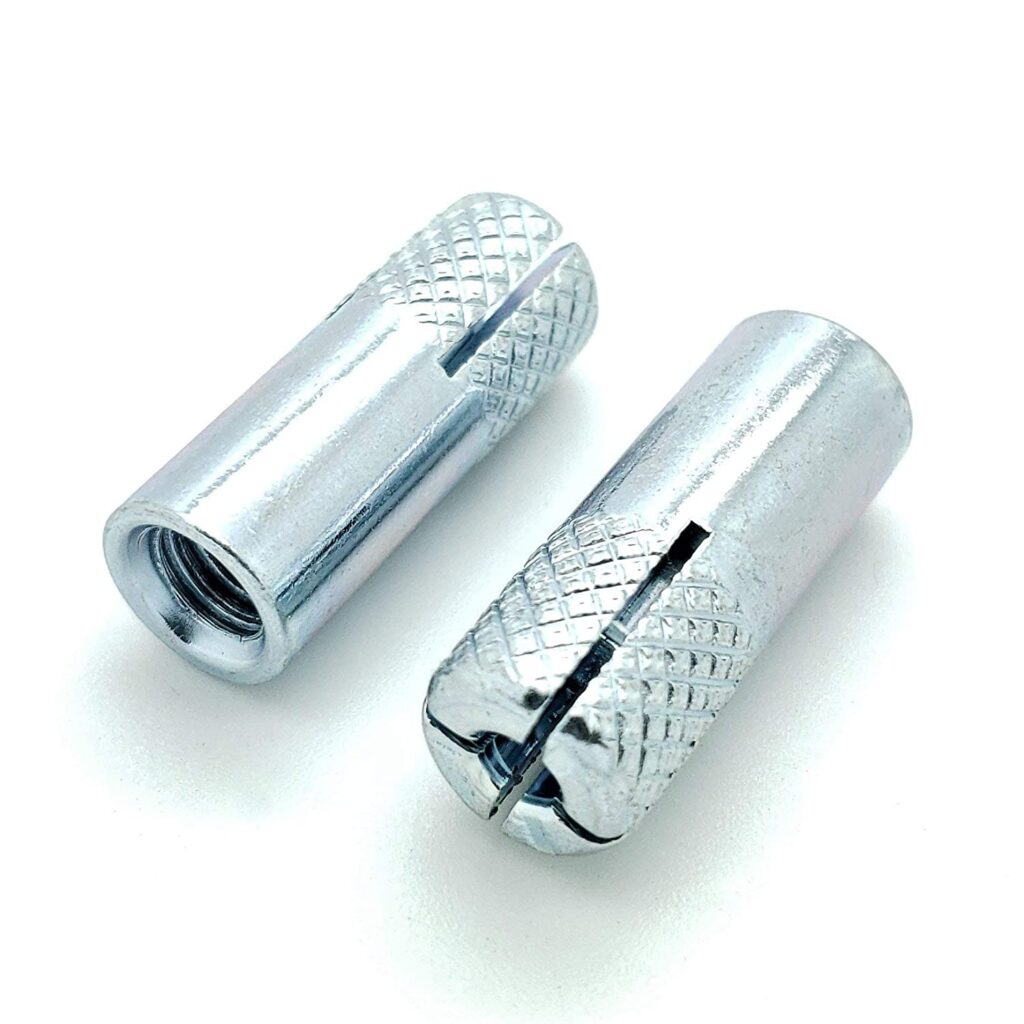Wedge Type
1. Wedge Anchor
Wedge anchors are one of the most commonly used types of concrete fasteners. They are installed into pre-drilled holes. They get their name because they wedge themselves as you tighten the nut. Make sure to clean the drilled hole for dust so your wedge anchor sits deep enough. Zinc plated wedge anchors can be used in interior and exterior non-corrosive applications and are a cheaper option. You can use 316 stainless steel wedge anchors for highly corrosive applications. Wedge anchors are designed for concrete use only.

Expansion Type
2. Drop-in Anchor
Drop-in anchors are also installed into pre-drilled holes. They area female anchor that requires a bolt to thread onto it. To secure this anchor you must hammer a setting tool onto the drop-in anchor. This will cause the anchor to expand in the hole. This type of anchor can only be used in concrete. You can also find drop-in anchors with coil threads meant for more coarse threads. Another variation of this anchor is to have a flange that won’t let it drop into a hole deeper than the anchor itself.

3. Machine Screw Anchor
The machine screw anchor is similar to the drop-in anchor as it has the same principle as a female thread. It also needs to be hammered with a setting tool. Unlike the drop-in anchor, the machine screw anchor can be used on concrete, brick, mortar joints, and block. Because it is a female thread whatever you bolt you screw in can be removed.

4. Leadwood screw anchor
Leadwood screw anchors are also female threaded concrete anchors. They can be used on a variety of materials such as brick, block, concrete, and drywall. Wood screws, lags, and tapping screws are used with this type of anchor. This type of anchor is intended for light function applications.
5. Single Expansion Anchor
The single expansion anchor is used on concrete, brick, or block. It is designed to be inserted into a pre-drilled hole and tapped in until flush. This type of anchor has a female thread that will accommodate a machine bolt. You can find this type of anchor in with a non-rusting material made of Zamac. When a machine bolt is inserted into this anchor the anchor will expand and make contact at a single point.

6. Double Expansion Anchor
This anchor is designed almost the same as a single expansion anchor but differs with its contact points. When a machine bolt is inserted into a double expansion anchor it will make contact with two points. This gives it a greater holding value when compared to a single expansion anchor.

7. Lag Shield Anchor
The lag shield anchor will sit in a pre-drilled hole and expand when a lag bolt is installed. This anchor will then flare out because of the split on its body expanding when the lag bolt is installed. The hole should be pre-drilled to the diameter of the lag shield anchor.

8. Split Drive anchor
Split drive anchors are designed so that they are permanently installed. You strike the head with a hammer into your predrilled hole. The split drive anchor is already expanded and will stay expanded against the walls it sits in. It is best suited in dry and non-corrosive locations. This anchor can only be used in concrete

9. Strike Anchor
A strike anchor gets its name from the fact you have to strike the head in order to install it. When you strike the head the bottom of the anchor will flare out and that will in turn hold your anchor in its hole. It also requires you to tighten a nut that will further tighten the anchor and secure it in place. You can use this type of anchor to secure plywood to concrete for example.

10. Toggle Bolt Anchor
Toggle bolts are common in drywall but can be used in hollow concrete. It goes through an existing hole and the wings will grab onto the wall as you tighten down the screw.

Sleeve Type
11. Sleeve Anchor
A sleeve anchor can be used in concrete, brick, and block. It needs to be inserted into a pre-drilled hole and the nut tightened. When the nut tightens it will drive the anchor upwards but the sleeve will expand due to the slits on the sleeve. Sleeve anchors can also come with a Phillips head fastener to tighten down instead of a nut.

Concrete Screw Type
12. Concrete Screw
Concrete screws are the most common type of masonry fasteners. They are simple to install, just pre-drill a hole and drive your screw in. There are different variations such as countersunk and different fastener heads. Tapcon screws are widely used when it comes to concrete screws.

Tips
When drilling a hole for a concrete anchor you can use tape to mark the distance of the hole needed on your drill bit. This can be used as an indication on when to stop drilling.
Always use safety glasses and hearing protection when drilling and installing anchors. Make sure to follow your local jurisdiction’s building code when choosing what concrete fastener to use.








